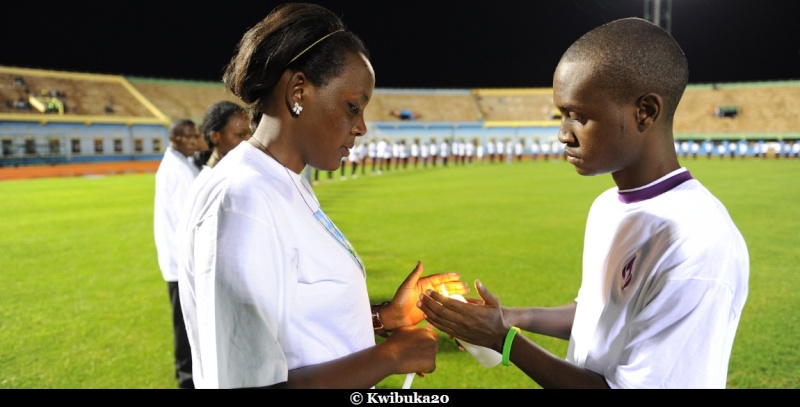Genocide against Tutsis in 1994 [From 7 April 1994 to 4 July 1994 ]
Over the course of 100 days from April 7 to July 4 1994, an estimated 1 million Tutsis and some moderate Hutus were slaughtered in the Genocide Against Tutsi.
A recent report has estimated the number to be close to 2 million.During this period of terrible slaughter, more than 6 men, women and children were murdered every minute of every hour of every day. This brutally efficient killing was maintained for more than 3 months.
There are between 300,000 to 400,000 survivors of the genocide. Between 250,000 and 500,000 women were raped during the 100 days of genocide. Up to 20,000 children were born to women as a result of rape.
Prior to the Independance
1918: Under the Treaty of Versailles the former German colony of Rwanda-Urundi is made a League of Nations protectorate to be governed by Belgium. The two territories (later to become Rwanda and Burundi) are administered separated under two different Tutsi monarchs. Rwanda Classification
Both Germany and Belgium turned the traditional Hutu-Tutsi relationship into a class system. The minority Tutsi (14%) are favored over the Hutus (85%) and given privileges and western-style education. The Belgians used the Tutsi minority to enforce their rule.
1926: Belgians introduce a system of ethnic identity cards differentiating Hutus from Tutsis.
1957: PARMEHUTU (Party for the Emancipation of the Hutus) is formed while Rwanda is still under Belgian rule.
1959: First massacre of Tutsi. 150,000 of them flee to Burundi, Congo, Uganda, and Tanzania. Rwanda-cartedidentite
1961-62: Rwanda and Burundi become two separate and independent countries.
After the Independance
1963: Further massacre of Tutsi. Again more refugees leave the country. It is estimated that by the mid-1960s half of the Tutsi population is living outside Rwanda.
1967: Renewed massacres of Tutsis.
1975: Habyarimana’s political party, the National Revolutionary Movement for Development (Mouvement Revolutionnaire National pour le Developpement,or MRND) is formed. Hutus from the president’s home area of northern Rwanda are given overwhelming preference in public service and military jobs. This pattern of exclusion of the Tutsis continues throughout the ’70s and ’80s.
Oct 1990: RPF (Rwandan Patriotic Front) invade Rwanda from Uganda. After fierce fighting which French and Zairean troops are called in to assist the government, a cease-fire is signed on March 29, 1991.
1990-91: The Rwandan army begins to train and arm civilian militias known as interahamwe (“Those who stand together”). For the next three years Habyarima stalls on the establishment of a genuine multi-party system with power-sharing. Throughout this period thousands of Tutsis are killed in separate massacres around the country. Opposition politician and newspapers persecuted.
Nov 1992: Prominent Hutu activist Dr. Leon Mugesera appeals to Hutus to send the Tutsis “back to Ethiopia” via the rivers
Feb 1993: RPF launches a fresh offensive and the guerillas reach the outskirts of Kigali. French forces are again called in to help the government side. Fighting continues for several months.
Aug 1993: Following months of negotiations, Habyarimana and the RPF sign a peace accord that allows for the return of refugees and a coalition Hutu RPF government. 2,500 U.N. troops are deployed in Kigali to oversee the implementation of the accord.
Sept 93-Mar 94: President Habyarimana stalls on setting up of power-sharing government. Training of militias intensifies. Extremist radio station, Radio Mille Collines, begins broadcasting exhortations to attack the Tutsis. Human rights groups warn the international community of impending calamity.
Mar 1994: Many Rwandan human rights activists evacuate their families from Kigali believing massacres are imminent.
The Genocide against Tutsis
Apr 7, 1994: The Rwandan Armed Forces (FAR) and the interahamwe set up roadblocks and go from house to house killing Tutsis and moderate Hutu politicians. Thousands die on the first day. U.N. forces stand by while the slaughter goes on. They are forbidden to intervene, as this would breach their “monitoring” mandate.
Apr 8, 1994: The RPF launches a major offensive to end the genocide and rescue 600 of its troops surrounded in Kigali. The troops had been based in the city as part of the Arusha Accords.
Apr 21, 1994: The U.N. cuts its forces from 2,500 to 250 following the murder of ten Belgian soldiers assigned to guard the moderate Hutu prime minister, Agathe Uwiliyingimana. The prime minister is killed and the Belgians are disarmed, tortured, and shot and hacked to death.
Apr 30, 1994: The U.N. Security Council spends eight hours discussing the Rwandan crisis. The resolution condemning the killing omits the word “genocide.”
June 22, 1994: With still no sign of U.N. deployment, the Security Council authorizes the deployment of French forces in south-west Rwanda. They create a “safe area” in territory controlled by the government. Killings of Tutsi continue in the safe area, although some are protected by the French.
July 1994: The RPF captures Kigali and stopped the genocide. The genocidaire government flees to Zaire, followed by a tide of refugees. The RPF sets up an interim government of national unity in Kigali.
Compiled from Fergal Keane’s Season of Blood and Alain Destexhe’s Rwanda and Genocide in the Twentieth Century
Une Parodie de Rendez vous en terre inconnue, sur le Génocide contre les tutsi
Kanombe Military Hospital staff provide free treatment to Genocide survivors
Rwanda Police and Rwanda Civil Aviation Authority pay tribute to the victims of the Genocide
Au Rwanda, les cicatrices du passé peinent à se refermer
PHOTOS : 19th Commemoration of the Genocie against Tutsi in Paris
19th Commemoration of the Genocide against Tutsi in the World








